Contents
Garden blackberries cannot be attributed to frost-resistant plants. Some of its cultivars can hardly tolerate temperatures of -15 ° C, therefore, in the conditions of the central strip of Our Country, where winters are harsh and long, its cultivation is not always successful. You can solve the problem by selecting special varieties that are well adapted to the cold. When choosing the best blackberry varieties for the Moscow region, it should be borne in mind that plants with erect stems are more winter-hardy, while creeping shoots do not tolerate low temperatures and require special care in winter, but they are more productive.
Features of growing blackberries
Blackberry is a sun-loving crop. Of course, it can bear fruit in the shade, as it happens naturally when it grows in the forest. However, in this case, even if the plants are given the best care, the berries will be small and unsweetened. Therefore, one of the main conditions for growing blackberries in the gardens of the Moscow region is planting a bush in a sunny and calm place. Blackberries grow best in the southern or southwestern part of the site, where the sun shines for more than half of the day.
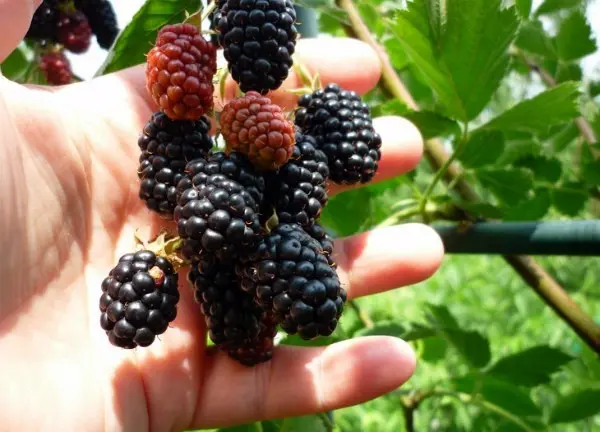
To date, many improved varieties and hybrids of blackberries have been bred, which are distinguished by large fruits, the absence of thorns on the shoots and other positive characteristics. However, they are all a variation of one of two basic forms:
- cumin (upright stems);
- dewdrops (creeping blackberries, the shoots of which reach several meters).
The care of blackberries largely depends on this feature. If only some of the varieties with erect stems need support, then all creeping blackberries, without exception, need vertical supports (trellises) not lower than 2 meters in height.
The planting pattern for cumanica and dewberry is also different. The first can be planted at a distance of 1,5–2 m between the bushes, while for creeping plants, planting at a distance of 2,5–3 m and at least 3 meters between rows will be optimal.
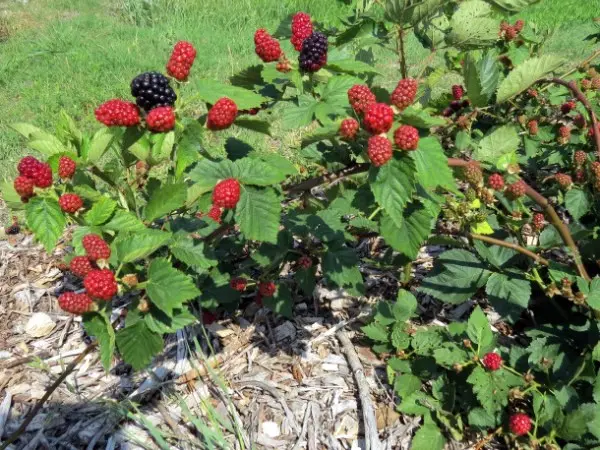
Blackberries need the right soil to grow. It should be light, well-drained, as the plant does not tolerate stagnant moisture. Loamy or sandy loamy soil with the addition of peat is best suited for kumanika. Creeping varieties are less demanding on the soil – they can grow on heavier soils, but in any case, the land must be fertile.
The lack of nutrients in the soil negatively affects the taste of the fruit. For example, from a lack of potassium, berries grow sour and not juicy enough.
Blackberries need regular watering in the first year, while the seedling is actively growing. Further, from the second year of the plant’s life, intensive watering is needed only during the formation of the ovary and the ripening of berries. The lack of moisture during these important periods can lead to the fact that the berries do not gain juiciness, sugar content and the desired weight, and during periods of drought they can completely dry out and fall off. However, you need to water in moderation, as prolonged waterlogging leads to root rot.

The most important activity that includes blackberry care is pruning. It is held twice a year: in spring and autumn. The blackberry has a two-year development cycle, which means that the useful life of the shoots is only two years. In the first year, the shoot simply grows, it is provided with proper care, and only in the second year inflorescences form on it and it bears fruit. After the harvest is obtained, the shoot is no longer needed, so it is cut out. Such pruning is carried out in the fall, so that in winter old and useless shoots do not deplete the bush. Spring pruning is more of a sanitary nature. It is carried out before bud break, and its purpose is to clean up damaged branches that have not survived the winter.
Since blackberries do not have high frost resistance, they need to be covered for the winter. Preparation for winter is carried out during autumn pruning: the shoots are shortened, removed from the trellis, bent to the ground and covered with insulating material. For a climate where the winter temperature does not exceed -20 ° C, only a thick layer of organic mulch (peat, sawdust, pine needles, dry foliage) can be dispensed with. In regions with more severe winters, blackberries should additionally be covered with insulation, for example, agrofiber.
Video “Blackberry Varieties”
From this video you will learn what varieties of blackberries can be planted in your summer cottage.
Preparing for planting
Planting blackberries is carried out in pre-prepared soil. A competent gardener begins to prepare a bed for blackberries in 2 years, sowing green manure on the site. It is believed that they better saturate the soil with useful substances than ready-made fertilizers applied to the soil. However, for those who do not have time for such a long preparation, you can simply apply mineral and organic top dressing directly to the planting hole.
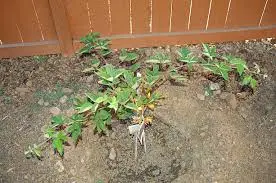
Blackberries love slightly acidic soil. It is acceptable if the acidity is neutral, but if your soil is alkaline, it must be brought back to normal with sulfur or ferrous sulfate. Too high acidity is neutralized with ash or slaked lime. If the seedlings are planted in rows, then the entire bed should be dug up, and if 1-2 bushes are to be planted, then you can limit yourself to a small area the size of the planting hole.

As mentioned above, for planting, you need to allocate a sunny and calm place, where you should dig planting holes or trenches (if the plants are planted in rows). Blackberries, unlike many berry crops, are best planted in the spring – so the seedling will have time to take root before the onset of cold weather. The most favorable time for planting is May – early June, but early varieties can be planted in April, as they tolerate cold more easily.
The seedling must be carefully inspected before planting. If it is not grown by you with your own hands, then you should pay special attention to the rhizome – the roots of the seedling are young, light, and by no means dry. Stems are smooth, uniform, not damaged. It is better to purchase a seedling in well-known nurseries with a good reputation.

Three Ways to Plant Blackberries
Landing technology
Planting blackberry seedlings is carried out in the following order:
- A landing pit (hole) is dug out with a diameter of 40–45 cm, a depth of up to 50 cm.
- A mixture of fertilizers is laid at the bottom of the pit (humus 0,5 buckets, superphosphate 100 g, any potash mixture 40–50 g), drainage is laid, if necessary, with the lowest layer.
- A layer of earth is poured on top of the fertilizer so that the pit is about a third filled.
- A seedling is placed vertically on this “pillow”, the rhizome is straightened.
- The pit is covered with earth to the brim so that the growth bud of the seedling is deepened by 2–3 cm.
- Then the earth is lightly tamped.
- A circular shallow hole is made around the plant (for watering) and 1-2 buckets of water are slowly poured into it.
- When moisture is absorbed, the trunk circle is mulched with a thin layer of peat, sawdust or other organic material – the mulch will retain moisture, prevent the growth of weeds, which will make it easier to care for the seedling.
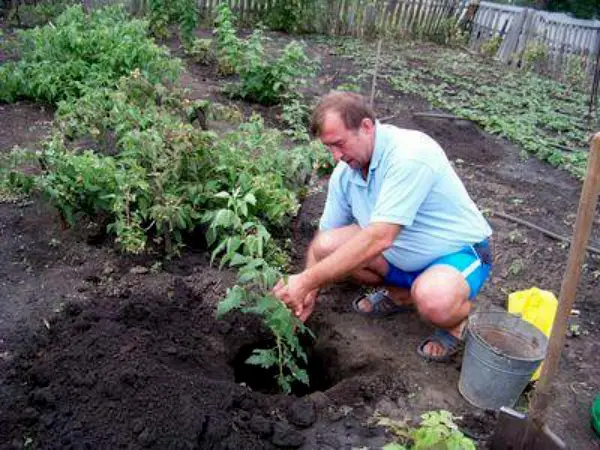
Care
Basic culture care consists of a number of activities:
- Watering. In the first year of life, the seedling is watered 2 times a week, and in subsequent years – only during periods of drought, as well as during ovary and fruiting. An adult blackberry bush has a fairly long main root, so the plant does not need frequent watering.
- Soil loosening. Periodically, it is necessary to loosen the soil in the trunk circles and between rows, while simultaneously removing weeds. Blackberries can grow in any neighborhood, but some weeds, such as leek, can cause significant damage to the plant’s roots. Mulch can be used to prevent weeds and thus facilitate plant care.
- Top dressing. Blackberry is not too demanding on fertilizers – it grows in the forest without them. And if you do not have the goal of getting large and tasty berries, then you can only get by with covering mulching for the winter. But if you want to get a crop characteristic of this variety, then you need to periodically feed the bushes with organic matter (compost, humus 5 kg / 1 sq. M), and apply potash fertilizers during the ripening period of the berries.
- Pruning. Formative care is required for all types and varieties of blackberries. The main pruning is carried out in autumn (September) after the end of the harvest. During autumn pruning, all the shoots that have fruited this year and some of the young annuals (grown this year) are removed under the root. Among the young, those that are not sufficiently developed (short, thin) are to be removed. For the winter, it is recommended to leave 8–10 of the largest young shoots. They are shortened (cut the tops) by a third. Spring pruning is carried out in order to remove all diseased and damaged branches during wintering. You can also slightly trim the tops – this procedure will awaken the plant and make it develop more actively.
- Shelter for the winter. After autumn pruning, the shoots are tilted to the ground and covered with insulating material: organic mulch or other denser materials.
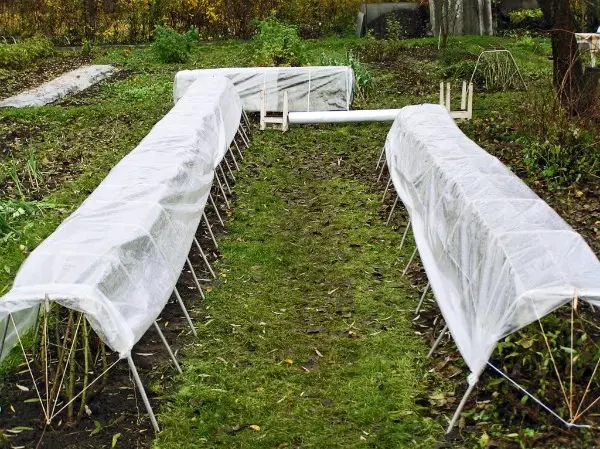
Plant care also involves preventive treatments against diseases and insects.
Blackberries are subject to the same pests as raspberries, but to a lesser extent. To avoid this, preventive treatment is carried out in the spring with light insecticides: Bordeaux liquid, a solution of copper sulphate.
Such activities are not required, but they will allow you not to be distracted by pest control in the season and are guaranteed to get a rich harvest.
Video “Blackberry in the Moscow region in autumn”
The author of this video tells how he grows Thornfree and Black Satin varieties at a dacha near Moscow. You will see how you can cover the blackberries for the winter so that they survive the cold.









